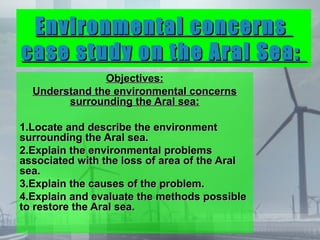
Aral sea
- 1. Environmental concerns case study on the Aral Sea: Objectives: Understand the environmental concerns surrounding the Aral sea: 1.Locate and describe the environment surrounding the Aral sea. 2.Explain the environmental problems associated with the loss of area of the Aral sea. 3.Explain the causes of the problem. 4.Explain and evaluate the methods possible to restore the Aral sea.
- 2. The Aral sea is located between Kazakhstan and Uzbekistan in what was once the old soviet union. It is fed by 2 rivers: the Syr Darya and the Amu Darya.
- 3. Climate of the Aral sea region (temperature) Temperature ranges from -13 to 28 °C. from March to November evaporation will take place reducing the water level in the lake unless recharged by rain or river flow.
- 4. Climate of the Aral sea region (rainfall). The animation shows that for most of the year there is little or no rainfall. This co-insides with the period of prolonged high temperatures seen in the previous slide. The result is that the climate of the area does not help the Aral sea recharge. Instead it has to rely on its two rivers to re-supply water to keep the lake from drying up.
- 5. This satellite image has been annotated to show what has happened to the lake! Describe what has occurred.
- 6. Using the climate data seen before suggest what reasons there could be for the sequence of events below.
- 7. The consequences of the lake reducing in size: Environmental problem: Knock on effect:
- 8. Causes of the Aral sea disaster: The diagram on the right shows the availability of water supplies to the main rivers as the blue bar. The level of water extraction is shown in red. Describe the availability of water vs the extraction and suggest what the effects will be. Combine the climatic data in your answer for higher marks.
- 9. Analysis of the solution impact pros Cons. solutions to restore the Aral sea. Pump in sea water. Because the Aral sea was Re-route able to survive despite the climatic conditions water. before humans Build dams. intervened there is no reason why it cannot be Plant re-filled. However, even if different the water is returned crops. there are no guarantees that the ecology will Use fewer recover. Even if it does it chemicals. will take a large number of years. A set of Drought proposals has been resistant identified that could be cotton. used to restore the water levels in the Aral sea. For Charging for each assess its impact water use. and the pros and cons for its implementation. Desalination. Irrigation channels
- 11. Answers: Pump in sea water: would slowly re-fill the sea. Easy to achieve and plentiful supply of water. Would allow cotton farming to continue. No loss of water in transit as piped. However, infrastructure required and would cost a lot. Also problem with environmental cost of powering the pumps. Re-route water: would allow sea to reform. Easy to achieve and permanent move. Not very environmentally damaging. Problems includes loss of farming and visual impact. Water still lost through evaporation. Build dams: stops the flow of water from leaving the sea allowing it to rebuild. The most effective solution but completely damages the environment and water ecosystems below the dam. Huge cost and visual impact. Plant different crops: will allow less water needed for irrigation so rivers are higher. Problems of having to re-train farmers and reduced income.
- 12. Use fewer chemicals: area becomes organic in 10 years time from start. Reduces the cost. Allows more natural species to return. Problems with insect pests and disease. Possible reduced growth of plants and therefore income that can be generated. Drought resistant cotton plants: less water needed for irrigation. Will protect from effects of global warming. Plants are more expensive and generate less cotton per plant so more land required to grow the same yield. Charging for water use: designed to force people to use less water. Generates problems between rich and poor. Not very effective. Rich will still not reduce their consumption. Desalination: the removal of salt from sea water allows for this to be used for humans. Infinite supply. Very expensive and water has to be pumped from sea to land when existing water supplies go in the other direction. Irrigation channels: same as for re-routing water.
- 13. Possible exam questions: There has been no exam yet but expect the following types of questions in the exam. 1.Describing the environment of the area. 2.Describing the rate of shrinkage (source E page 5). 3.Describing the rate of shrinkage or the area lost (projections on page 5). 4.Explaining the climate of the area. 5.Explaining the causes of the loss of water level (source F page 6). 6.Explaining the ecological problems created as a consequence of the water level dropping (source F). 7.Explaining the economical problems created as a result of the water levels dropping (source F). 8.Assessing the solutions to restore the area back to its original state (source G page 7). 9.Decision making to pick some of the options to implement and justifying your decision. 10.Assessing the effectiveness and costs of implementing the solutions and their chance of success.